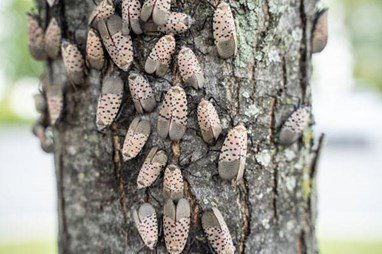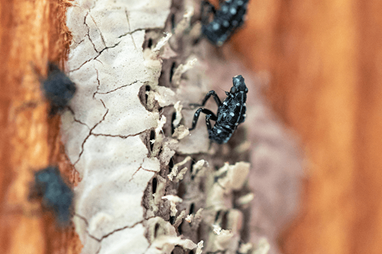Sure, cold temperatures, bitter winds, and those snow and ice piles can make the winter months a bit less desirable for us all.

But for people who have had to battle the relentless spotted lanternfly (SLF), winter can’t come soon enough.
This pest, which is native to China and parts of southeast Asia, was first discovered in the U.S. in 2014. And though it’s a rather colorful species, it’s also a super hungry pest, feeding on at least 70 species of trees, as well as shrubs and ornamentals.
In regions where it’s been spreading, it’s not only feeding on your trees, it’s leaving behind a sticky excrement called honeydew. This tacky substance is a nuisance on your patio furniture, and it attracts other insects and promotes the growth of sooty mold.
None of this is the kind of picnic you are after in your backyard.
But, it’s winter! So you can take a breather, right? Think again. While the spotted lanternfly adults do not survive the winter, the same isn’t true for their egg masses, which are unfortunately hardy enough to withstand colder weather conditions.
You want to take back control of your yard so you can have summer picnics and barbecues outdoors again. We understand that.
Follow these tips for dealing with spotted lanternfly so you don’t have to battle more adults come spring and summer.
Does Cold Weather Kill Spotted Lanternfly?
Despite the fact that the spotted lanternfly is not native to the U.S., the climate in areas like the Northeast U.S. in states like Pennsylvania and New York seem to make this insect pretty happy.
The SLF repeats an annual life cycle each year, spreading fairly easily. And that life cycle starts in summer when the adults mate and lay eggs. These eggs are gray, semi-flat clusters. They have a protective coating that looks a bit like mud, and the insects lay them on all kinds of outdoor surfaces.

Then in spring, those eggs hatch nymphs that have black and white spots. Many of the black spots turn red as the bugs grow into teenagers.
Adults are approximately 1-inch long and have pretty patterns of red, white, black, and beige on their wings.
And to grow so quickly into this beautiful bug takes eating … and quite a lot of it. Your yard provides the perfect free buffet of tasty treats. While they prefer tree-of-heaven, they also dine on apple, oak, maple, willow, and other deciduous trees.
Does cold weather kill spotted lanternflies? Yes, but only the grown-ups. The eggs survive the winter and create the whole vicious cycle all over again come springtime.
Once you understand the spotted lanternfly lifecycle, the goal is to eliminate the egg masses so you don’t have to deal with the adults. You can do this by walking your property from September through April and checking for the egg masses on trees, cement, rocks, and other hard surfaces. Scrape them off of surfaces and put them in a container or bag with a bit of hand sanitizer or rubbing alcohol. You can also smash them.
How To Get Rid Of Spotted Lanternflies
If you missed a chance to remove the eggs, there are other options you can explore regarding how to kill spotted lanternfly.
And this is important because as they feed on your trees, they strip them of nutrients and weaken them. A weak tree may not only lose years of its life, but it also may become victim to other insects and diseases.

One option for getting rid of lanternflies is eliminating the tree-of-heaven in your yard. But if the insect is feasting on other trees, an insecticide application by a professional tree care company is proving effective at helping control them.
Another important step to take if you see spotted lanternflies on your property is to inform your state’s Department of Agriculture so they can continue to monitor the SLF’s spread. This information can be helpful in its efforts to reduce pest populations.
Does Dawn Dish Soap Kill Spotted Lanternfly?
When an invasive pest like the spotted lanternfly comes into the U.S., an Internet search always reveals a bunch of suggestions for battling it.
One such idea is diluting dish soap in water and spraying it on your plants. Unfortunately, these home remedies may not only be ineffective at getting rid of lanternflies but when applied incorrectly they could also harm your plant.
Registered pesticides, approved by the U.S. EPA, go through extensive testing. And when they are applied minimally by professionals, they not only control the pest but also keep your trees safe.
Spotted Lanternfly Predators
The spotted lanternfly is developing some natural predators in the U.S. -- mainly praying mantises and some other insects, as well as a couple of types of birds.
However, no natural predators are having a great impact on reducing insect populations so far.





